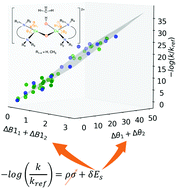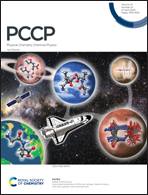Linear free energy relationships for transition metal chemistry: case study of CH activation with copper–oxygen complexes†
Abstract
We propose a computational framework for developing Taft-like linear free energy relationships to characterize steric effects on the catalytic activity of transition metal complexes. This framework uses the activation strain model and energy decomposition analysis to isolate electronic and geometric effects, and identifies structural descriptors to construct linear relationships. We demonstrate proof-of-principle for CH activation with enzyme-inspired [Cu2O2]2+ complexes coordinated to bidentate diamine N-donors. Electronic effects are largely similar across chosen systems and geometric effects – quantified by strain energies – are accurately captured by a linear combination of two structural descriptors. A powerful linear free energy relationship emerges that is transferable to asymmetrically substituted complexes. We outline steps for expanding this approach to create a generalizable Taft framework for inorganic catalyst design.

- This article is part of the themed collection: 2020 PCCP HOT Articles


 Please wait while we load your content...
Please wait while we load your content...